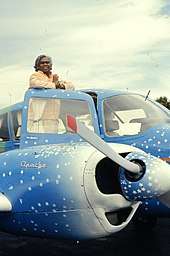Vishnudevananda Saraswati
Vishnudevananda Saraswati (31 December 1927 – 9 November 1993) was a disciple of Sivananda Saraswati, and founder of the International Sivananda Yoga Vedanta Centres and Ashrams. He established the Sivananda Yoga Teachers' Training Course, one of the first yoga teacher training programs in the West. His books The Complete Illustrated Book of Yoga (1960) and Meditation and Mantras (1978) established him as an authority on Hatha and Raja yoga. Vishnudevananda was a tireless peace activist who rode in several "peace flights" over places of conflict, including the Berlin Wall prior to German reunification.
Vishnudevananda Saraswati | |
|---|---|
 | |
| Born | Kuttan Nair 31 December 1927 |
| Died | 9 November 1993 (aged 65) |
| Occupation | Yoga guru, peace activist |
Early life
Vishnudevananda was born Kuttan Nair in Kerala, South India, on 31 December 1927.[1] His family were members of a Nair caste.
During his short career in the Indian Army, he was inspired by a pamphlet, Sadhana Tattwa, written by Sivananda Saraswati.[1] He travelled twice to Rishikesh to meet Sivananda. At his second visit, he and others waited as Sivananda ascended the stairs from the bank of the Ganges to the ashram. When Vishnudevananda declined to prostrate, Sivananda surprised him by prostrating before him. This lesson in humility was the first given to Vishnudevananda by his guru.
Training
Vishnudevananda entered the Sivananda Ashram in Rishikesh in 1947 at the age of twenty.[1] He took sannyas (became a monk) in February 1949[1] and was appointed the first professor of hatha yoga at the Sivananda Yoga Vedanta Forest Academy. In this capacity, he trained scores of Indian and Western students. At the same time he continued his own practice, mastering advanced hatha yoga techniques.
He would tell the story at evening meditations of how one day in 1957 Sivananda placed a symbolic 10 rupees (about $0.15 USD) in Vishnudevananda's palm and instructed him to bring the ancient teachings of yoga (Vedanta) to the West. "People are waiting," Sivananda said.
Centers and ashrams
Vishnudevananda travelled throughout North America, teaching yoga and observing the western life style. He founded the first Sivananda Yoga Vedanta Centre in Montreal, Quebec, Canada, in 1959.[2][3] Shortly thereafter, in 1961, he called into life the first yoga vacation in Val Morin, Quebec, (on 11th Avenue), which has since become a tradition in the Sivananda Yoga Vedanta Centres and Ashrams.[4]
In February 1962, Vishnudevananda saw the present site of the Yoga Camp in Val Morin, and intuitively chose to settle in the dense forest area near the Laurentian Mountains. The Sivananda Yoga Vedanta Centre was opened there on 19 September 1962 by Marcia Moore, an American trained by Vishnudevananda a few years earlier.[4] Since then, it has expanded to include several temples, a yoga hall, guest lodges and offices, a swimming pool and a sauna.
In 1967, Vishnudevananda founded the Sivananda Ashram Yoga Retreat on Paradise Island in the Bahamas.[5]
In August 1971, the Sivananda Ashram Yoga Farm was established in Grass Valley, California.[5]
In 1974, Vishnudevananda inaugurated a fourth ashram, in Woodbourne, New York, near the Catskill Mountains.
In February 1978, Vishnudevananda inaugurated the Sivananda Yoga Vedanta Dhawanthari Ashram in Neyyar Dam, near Thiruvananthapuram in the foothills of the Sahyadri Mountains in Kerala.[5]
A small Himalayan ashram, Sivananda Kutir, was established in Netala, just outside Uttar Kashi on the banks of the Ganges and was to become the site of Vishnudevananda’s jala-samadhi (sacred drowning).
Today the organization founded by Vishnudevananda has nine ashrams and 19 centers around the world. In addition, it has many affiliated centers and has trained thousands of teachers who continue to disseminate the ancient wisdom of yoga.
Peace missions

In reaction to a vision of a world in peril, Vishnudevananda began his peace mission. The first act was to create the Sivananda Yoga Teacher Training Course in 1969, as he felt the need to train future leaders and responsible citizens of the world in the yogic disciplines. Later he conducted peace flights over the world's trouble spots, earning himself the name "The Flying Swami".
On 30 August 1971, Vishnudevananda flew from Boston to Northern Ireland in his Peace Plane,[6] a twin-engine Piper Apache plane painted by artist Peter Max. His Vedantic message, "Man is free as a bird", challenged all man-made borders and mentally constructed boundaries. Upon landing, he was joined by actor Peter Sellers and they walked through the streets of Belfast chanting a song called "Love Thy Neighbor as Thyself." Later that same year, on 6 October, he took off with his co-pilot Bren Jacobson, who had been with him during the entire trip, from Tel Aviv to fly over the war-ridden Suez Canal and was buzzed by Israeli jets. The same thing happened with the Egyptian Air Force on the other side of the Canal. He continued eastward, "bombing" Pakistan and India with flowers and peace leaflets.
On 15 September 1983 Vishnudevananda flew over the Berlin Wall, from West to East Berlin, in a highly publicized and dangerous mission to promote peace.[7][8] Vishnudevananda returned to Berlin when the Wall fell in 1989, staging a peace festival and a brief meeting with then-East German leader Egon Krenz to thank him for allowing the events to unfold peacefully.
In 1984, Vishnudevananda and his students toured India in a double-decker bus, conducting programs to awaken the Indian people to their ancient tradition of yoga. In February he tried to mediate between the Hindu and Sikh factions in Amritsar, entering the Golden Temple to speak to the Sikh leaders who had sought refuge there.[8]
Over the years, Vishnudevananda met regularly with other spiritual and religious leaders to promote interfaith dialogue and understanding. He organized yearly symposia on such topics as yoga and science, the possibilities of the mind, sustainable living and nuclear disarmament.
Vishnudevananda died on 9 November 1993. His body was then placed into the Ganges at the Sivananda Kutir, and the rite named jalasamadhi was performed, merging the abandoned body with the water.
Legacy
Vishnudevananda condensed the teachings of classical yoga into five principles: proper exercise, proper breathing, proper relaxation, proper diet (vegetarian), and meditation and positive thinking. The Sivananda Yoga Vedanta Organization founded by Vishnudevananda has centers and ashrams around the world. It is one of the largest training bodies of yoga teachers in the world, having produced over 45,000 graduates since the Sivananda Yoga Teachers’ Training Course was first inaugurated in 1969. His motto was, "Health is Wealth. Peace of Mind is Happiness. Yoga Shows the Way."
He is known also for having introduced The Beatles to yoga in the 1960s.[9]
In 2019, the Board of Directors of The International Sivananda Yoga Vedanta Centres published an apology for not believing the allegations made in 2007 by Vishnudevananda's assistant Julie Salter about sexual abuse committed against her by Vishnudevananda. Salter had posted her testimony to Facebook on December 10th, 2019.[10] The Board subsequently promised to run an independent investigation of the allegations made by Salter and others, including Pamela Kyssa, who disclosed on Salter's thread that Vishnudevananda had raped her in 1974.[10][11] The appointed investigator, Marianne Plamondon of Langlois in Montreal, declined to comment on whether the results of the investigation would be made public. [12]
Selected bibliography
- The Complete Illustrated Book of Yoga (1960)
- Meditation and Mantras (1978)
- A Commentary on the Hatha Yoga Pradipika
- Karma and Disease
See also
- Sivananda Yoga
References
- "His Holiness Sri Swami Vishnudevananda Saraswati Maharaj". Divine Life Society. Retrieved 25 March 2019.
- "H.H. SWAMI. SIVANANDA MAHARAJ JI". Sivananda Sevas. Retrieved 25 March 2019.
- Krishna 1995, p. 15.
- Goldberg 2016, p. 322.
- Krishna 1995, p. 16.
- Mullally, Una (26 January 2019). "The Way We Were: Hippies with plans for Skerries". The Irish Times.
- "AROUND THE WORLD; A Swami Flies Over The Berlin Wall". The New York Times. 16 September 1983.
- Krishna 1995, p. 17.
- Roth, Martin (12 September 2016). "Let's harness the revolutionary optimism of the 1960s to counter dark times". The Guardian. Retrieved 25 March 2019.
- Salter, Julie (10 December 2019). "Julie Salter". Facebook.
- "Statement by the Board of Directors of The International Sivananda Yoga Vedanta Centres". 16 December 2019. Archived from the original on 17 December 2019. and archived screenshot, same date
- Remski, Matthew (27 January 2020). "How a #MeToo Facebook Post Toppled a Yoga Icon". Medium.
Sources
- Goldberg, Elliott (2016). The Path of Modern Yoga : the history of an embodied spiritual practice. Inner Traditions. ISBN 978-1-62055-567-5. OCLC 926062252.CS1 maint: ref=harv (link)
- Krishna, Gopala (1995). The Yogi: Portraits of Swami Vishnu-devananda. Yes International Publishers. ISBN 978-0-936663-12-8.CS1 maint: ref=harv (link)
External links
- Vishnudevananda Saraswati at International Sivananda Yoga Vedanta Centres
- Swami Sivananda (1887–1963) at Sivananda Yoga Europe

